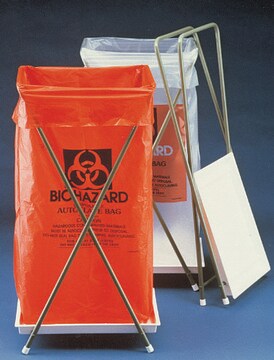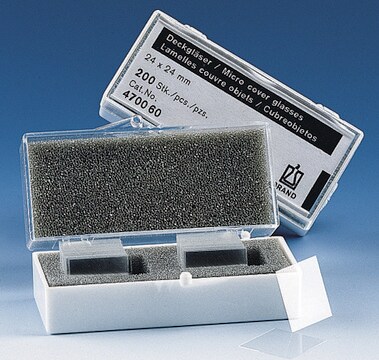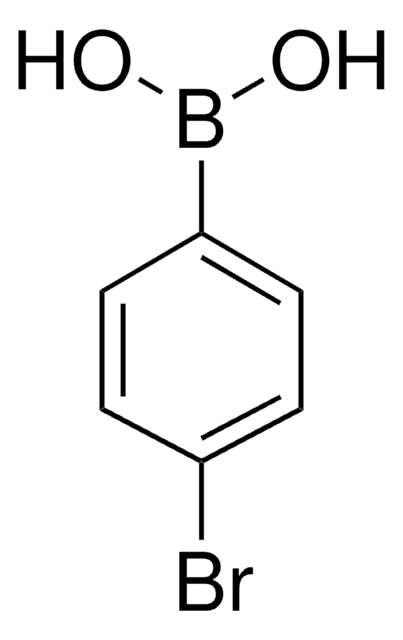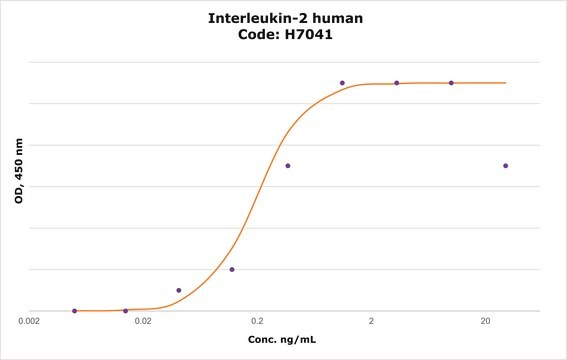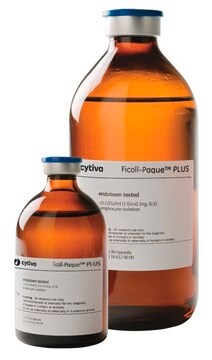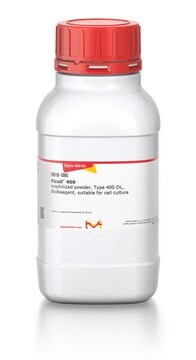690PB-100A
Human Mononuclear Cells: HMNC, adult
Synonim(y):
HMNC, HMNC cells
About This Item
Polecane produkty
pochodzenie biologiczne
human peripheral blood
Postać
solid
opakowanie
pkg of 10,000,000 cells (HMNC-PB)
producent / nazwa handlowa
Cell Applications, Inc
tryb wzrostu
Suspension
kariotyp
2n = 46
morfologia
mononuclear
metody
cell culture | mammalian: suitable
powiązane choroby
acquired immunodeficiency syndrome/human immunodeficiency virus (AIDS/HIV); infectious diseases; autoimmune diseases
Warunki transportu
dry ice
temp. przechowywania
−196°C
Opis ogólny
The leukocytes can be divided into two groups: mononuclear and granulocytic cells. The mononuclear cells mainly consist of lymphocytes and monocytes. The lymphocyte population consists of T cells (CD4 and CD8 positive ~75%), B cells and NK cells (~25% combined). In contrast to the granulocytes, these cells have rounded nuclei, some with indentations or folds. The mononuclear cells are involved in various ways with the body′s defense mechanisms.
1. These cells are critical components in the immune system to fight bacterial, viral infections, and function as immune surveillance network to kill tumor cells. The mononuclear cells also secrete a great variety of cytokines to regulate immune response as well as inflammation. Moreover, it has been demonstrated that the mononuclear cells may mediate various biological effects on other tissue and organs. For example, the chemokines produced by monocytes can act on adipocytes and muscles. Human Mononuclear Cells (HMNC) are often extracted from from bone marrow (BM) or peripheral blood (PB) using Ficoll-Hypaque density gradient centrifugation, a hydrophilic polysaccharide that separates layers of blood, with mononuclear cells forming a buffy coat under a layer of plasma. Generally, this buffy coat mainly contains lymphocytes and monocytes, other cell types such as cells are detected in Human Mononuclear Cell (HMNC) preparation.
2. Human Mononuclear Cells (HMNC) are widely used in research and clinical applications every day. The HMNCs are important tool for various studies in the fields of immunology (including auto-immune disorders), infectious disease, hematological malignancies, vaccine development, transplant immunology, and high-throughput screening.
3. HIV research uses them because PBMCs include CD4+ cells, which are the cells HIV infects.
4. Moreover, HMNCs have been accepted as a unique material for cancer immunotheurapy using dendritic cells or activated lymphocytes as an alternative or adjuvant to conventional therapies such as surgery, chemotherapy and radiation treatment.
5,6. Endothelial progenitor cells derived from HMNC have been used in neovascularization to improve limb ischemia
7. In cell therapy to repair ischemic and infracted myocardium.
8. Human Mononuclear Cells (HMNC) should provide a useful tool for studying various aspects of pathology and biology of the human mononuclear cells in vitro.
Human Mononuclear Cells (HMNC) are derived from human peripheral blood (HMNC-PB) using Ficoll-Hypaque density gradient centrifugation. They are cryopreserved immediately after isolation.
1. Allison, A.C. et al, Annu. Rev. Immunol. 1:361 (1983); 2. Sales, V.L. et al, Tissue Eng. 13:525 (2007); 3. Juranic, Z. et al, J. Exp. Clin. Cancer Res. 18:317 (1999); 4. Vicenzi E. et al, J. Leukoc. Biol. 68:405 (2000); 5. Steinman, R. M. et al, Int. J. Cancer 94:459 (2001); 6. Schuler, G., Cancer Immunity 3 (Suppl 1):23 (2003); 7. Kalka, C. et al, Proc. Natl. Acad. Sci. USA 97:3422 (2000); 8. Masuda, H. et al, Cardiovasc. Res. 58:390 (2003)
Pochodzenie linii komórkowej
Zastosowanie
Komponenty
Uwaga dotycząca przygotowania
- Immediately after isolation, 10,000,000 HMNC-PB in DMEM containing 45% FBS & 10% DMSO
- Blood cells do not proliferate in culture
Rutyna subkultury
Oświadczenie o zrzeczeniu się odpowiedzialności
Kod klasy składowania
11 - Combustible Solids
Klasa zagrożenia wodnego (WGK)
WGK 3
Temperatura zapłonu (°F)
Not applicable
Temperatura zapłonu (°C)
Not applicable
Certyfikaty analizy (CoA)
Poszukaj Certyfikaty analizy (CoA), wpisując numer partii/serii produktów. Numery serii i partii można znaleźć na etykiecie produktu po słowach „seria” lub „partia”.
Masz już ten produkt?
Dokumenty związane z niedawno zakupionymi produktami zostały zamieszczone w Bibliotece dokumentów.
Klienci oglądali również te produkty
Protokoły
Technical information for working with human mononuclear cells – periphery blood including thawing, subculturing and cryopreservation
Nasz zespół naukowców ma doświadczenie we wszystkich obszarach badań, w tym w naukach przyrodniczych, materiałoznawstwie, syntezie chemicznej, chromatografii, analityce i wielu innych dziedzinach.
Skontaktuj się z zespołem ds. pomocy technicznej


